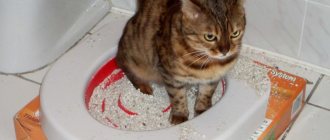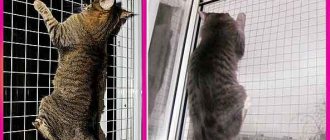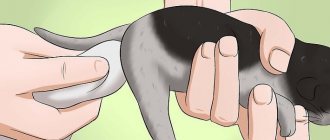Heated discussions regarding cat self-walking have divided cat owners into two camps. Some of them believe that a domestic cat should not leave the confines of an apartment or house, while others argue that forced confinement within four walls can hardly be considered caring for a pet. However, there are situations when the animal must be under the constant supervision of the owner (illness, injury, condition after surgery, estrus, etc.), and then it is necessary to re-educate the mustachioed-striped one, instilling in him an exclusively home regime.
“I, a cat, go wherever I please, and I walk on my own.”
Some purebred cats that have never left the apartment perceive the street as an alien environment and experience severe stress if they accidentally find themselves outside their native walls. Transporting such animals turns into a whole adventure, and training them to walk on a leash turns into a long training process.
However, most representatives of the cat tribe are freedom-loving and independent, therefore, having once tasted freedom, they will be eager to go outside again and again. It is noteworthy that the mustachioed striped animals seem to store within themselves all the experience of their wild ancestors and very quickly adapt to life in the natural environment. The street is attractive to cats for many reasons, including:
- Genetic memory of ancestors . This applies to the ubiquitous cats of the “noble” breed, whose parents and grandparents led a free life and took care of their own food and safety.
- Hunting instinct . A bloodthirsty predator slumbers in every murka, so the innate desire to ambush neighboring pigeons or the excitement of mouse hunting can provoke frequent unauthorized absences.
- Territorial instinct . A cat considers an apartment to be its territory, but individuals leaving the home expand their private boundaries and set up “control points” in the form of scent marks. Once in the wild, the first thing the cat does is walk around its property, examine the “messages” from its relatives and update its personal marks.
- Sexual instinct . The instinct of procreation forces sexually mature animals to persistently look for a mate and have offspring. Everyone knows the loud night serenades of March cats and brutal fights with opponents. Periods of sexual heat in cats (estrus) can also proceed very violently, accompanied by refusal to eat, characteristic poses and calling calls.
- Orienting instinct . Curiosity and the desire to discover new horizons are especially characteristic of young animals, so striving outside for a cat means fighting boredom and monotony.
- Social behavior . Despite the fact that many cats are loners, they are not alien to communication with their relatives and the corresponding manifestation of emotions.
- Need for physical activity . Domestic cats spend up to 18 hours a day in a sleepy and drowsy state, but exercise and exercise are important for them to maintain muscle tone and overall health. In freedom, this can include cross-country running, jumping, gymnastics and overcoming various obstacles.
- Energy discharge and activation of metabolism . Undoubtedly, cats with regular access to the street do not suffer from poor appetite, physical inactivity and obesity.
- Psychological hardening and personal experience . On the street, the animal is exposed to various stimuli, including negative and potentially dangerous ones, but gradually learns to choose the right course of behavior and resist stress factors. Undoubtedly, the nervous system of a street cat is much more stress-resistant than the pampered psyche of an animal that considers the apartment its whole world.
- Change of residence . It is known that cats are more attached to a place than to their owner. Therefore, moving may provoke a desire for the mustachioed one to return to his homeland.
- Lack of contact with the owner, bad attitude . Despite the relative independence of cats and the ability to distance themselves when communicating with people, they are very sensitive to negativity and may prefer the street to a home where they are not welcome.
Do not show signs of attention to the cat at the doorstep
Many owners like to say goodbye to their cat or greet him right at the door . This place becomes special for your pet, because here he is shown signs of attention.
To make a threshold a no-go zone, try changing your behavior. Pretend not to notice the cat when you come home or leave the apartment if he meets or accompanies you at the doorstep. It is better to greet or say “bye” to the kitty in another place. For example, in the living room, bedroom or kitchen. This way you will indicate to the cat the place where it is best to meet and see you off.
2. Organize a cozy place for the cat with a good view
Cats are territorial animals. It is important for them to protect the territory from outside attacks and find sources of danger outside. Moreover, a cat can consider even the territory beyond the threshold of the apartment to be its territory. Therefore, an attempt to escape is often associated with instincts.
Give your cat a place that can compete with what's outside the door. For example, let it be on the windowsill, from where the cat can view his possessions. Lay down a blanket, a bag of catnip, a favorite toy, open the view of the window by raising the curtains and blinds, and the cat will surely love the new place.
A window sill is an ideal place for cats to look around their cat property.
Motivating the cat to stay in place at the right time
Now all that remains is to accustom the pet to its place. A treat is suitable for this. Whenever you are about to leave the house, give it to the cat if he is in his place. If this does not happen, the treat is canceled. As a result of such an experiment, the cat will understand that at the moment of leaving it is better for him to be on the windowsill, because this is the only way he will receive a reward. Here's how to stop your cat from running out the door!
Dangers of self-walking
Accustomed to going AWOL, the cat usually returns home, but the absence can last several days and is associated with various dangers and troubles.
A cat walking on its own can:
- die under the wheels of a car;
- wander far from home and get lost;
- become a victim of flayers;
- being maimed or killed by dogs;
- get injured in a fight with rival cats;
- contract an infection or parasites;
- eat poisoned bait or rodent;
- to climb a tree out of fear and not be able to get down.
The result of a female cat's street adventures is usually an unexpected litter that has to be disposed of. In addition to such surprises, the roaming cat increasingly moves away from the owner and becomes, in fact, a stray animal, coming home once every couple of days to eat and take a little nap.
Take your kitty for a walk
How to stop a cat from running away from home? If your pet really wants to go outside, then it would be a good idea to introduce her to the street . A walk together will help satisfy the cat's interest and will be great entertainment. True, you need to thoroughly prepare for going out, otherwise the acquaintance may be unsuccessful.
- You can only walk with a healthy kitty that has been vaccinated against major cat infections, including rabies.
- It is forbidden to walk with a cat during estrus.
- First you need to buy a harness from. A leash for cats is not the best solution because cats have very delicate necks.
- Then, the kitty needs to be accustomed to a harness . Dress her up and try walking around the house together. After several such walks at home, you can move on.
- Do not take your cat directly outside on its first walks. First, introduce her to the entrance . If your pet is afraid, you can carry her out in your arms.
- When the cat is ready to walk outside the entrance, choose a quiet place for a walk and the optimal time when there will be the least number of cars and passers-by .
- Take your cat out for walks only with a harness . At first, she may be alarmed by loud noises and oncoming people. If your cat gets scared, stop walking and take her home immediately.
Ways to wean a cat off the street
If the owner has firmly decided to turn a freedom-loving animal into a purring pet, then he will have to radically change the pet’s behavioral habits and its psychology.
Undoubtedly, indoor confinement will at first be perceived as “house arrest,” and a cat accustomed to walking on its own will protest, get nervous, and persistently ask to be freed.
For the idea of “domestication” to be successful, first of all, additional measures are needed to correct the interior, namely:
- It is necessary to install strong mosquito nets or bars on the windows so that the mustachioed one cannot dive into the window or squeeze through the gap when the windows are open in ventilation mode. Having a cat within a closed balcony will brighten up the adaptation period, but if there is an open balcony, it is necessary to exclude the pet from access there.
- To reduce the cat’s desire to scratch the front or balcony door, jump on it and loudly lament about its plight, it is necessary to make the door an unpleasant and even frightening object. For these purposes, they use repellent sprays from pet stores, applying the contents of the container to the door leaf, laying out fresh citrus zest nearby, or simply stopping the cat’s decisive actions by spraying a stream of water from a spray bottle into its face, clapping their hands, or expressing their disapproval with a loud shout. If the cat knows how to open the door on its own by pressing the handle, then it is recommended to place a small light box with dry peas on top, and as soon as the tailed smart guy pulls the handle, the peas will begin to bombard from above without physically causing harm.
- To diversify the cat's leisure time, purchase various toys, a play complex with hammocks, hanging shelves, multi-level houses and teasers, as well as scratching posts of various configurations. So that the pet does not get bored and can realize its hunting instincts, the owner must allocate about an hour of time every day for active games and fun with the cat, training and practicing tricks. A splash of energy in the right direction and the development of good manners will prevent such unwanted manifestations of cat protest as torn curtains, scratched furniture and torn wallpaper.
- An “arrested” cat who is upset will need a secluded corner where he can calm down and fall asleep. Such a personal space can be a comfortable bed, a closed frame house or a soft “burrow-tunnel”. It is strictly forbidden to disturb an animal that has entered its den.
- In order to train to the toilet within an apartment, it is necessary to purchase a tray of a suitable size and wood filler that is as close as possible to natural litter. Felinologists recommend installing 2-3 trays in different places, giving the cat the opportunity to independently choose the most suitable place. The main rule is that the toilet area should not be located close to the cat’s dining room or sleeping area.
Provide your kitty with entertainment
Cats often get bored in the apartment. If you have few games, the kitty will have to come up with entertainment for herself. Jumping out the door is quite a fun activity, because beyond the threshold there are many smells and sounds that have not yet been explored. And the owner jumping after you will only add to the thrill of the sensations.
Changing this behavior is not difficult - you need to occupy the kitty with something more interesting. Here are a few ideas on how to stop a cat from running out into the hallway by providing it with games:
- Balls
- Game with feathers on a fishing rod
- Interactive games with food: buy a labyrinth where the food is hidden
- Catnip toys
- Climbing houses
Interactive toys are a great solution that will keep your cat busy, even if you are busy.
Drug treatment
Today, veterinary pharmacies offer several types of medications that can eliminate the symptoms of estrus. Veterinarians advise avoiding too frequent use of such products, since they contain a high concentration of active substances, which negatively affects the cat’s body.
Medicines have a negative effect on the animal’s reproductive system, artificially causing inhibition of natural processes in the body. They often lead to the formation of breast tumors and the development of malignant neoplasms of various localizations.
The listed consequences of taking drugs, most of which are made on the basis of hormones, make them undesirable methods for eliminating the manifestations of estrus.
I want to castrate my cat, but will it help...
Subsequently, the craving for this wall will disappear.
Scaring sound. Foil around a favorite spot will make the cat afraid. Subsequently, he will think ten times whether to mark or not.
Unpleasant sensations. To call them, you can use double-sided tape. If you paste it around the usual marked place, the pet will stick every time it wants to leave a mark.
Creating favorable conditions for the animal to live. The cat must be fed and happy. The toilet must be kept in good condition. Every few months, your pet needs to undergo a preventive examination by a veterinarian to prevent various painful conditions. Ideally, keep the male without competitors, then there will be no need to mark the bed of his owner out of jealousy.
General information about castration
Castration is a surgical operation to remove the testicles (testes) of a cat. This is the only procedure that guarantees control over a cat’s sexual desire and related problems.
The operation is performed under general anesthesia, which requires certain preparation.
Even if the cat looks absolutely healthy, 2 weeks before castration you need to carry out parasite prevention and show your pet to a veterinarian.
Before castration, the cat must receive a full course of vaccination or revaccination.
The veterinarian examines the cat for breathing and heart problems. If the doctor has any doubts, he will recommend contacting a veterinary cardiologist.
The cat's blood must be taken for analysis. Contraindications for the use of anesthesia are:
Reduced hemoglobin - indicates anemia, which can cause severe complications when recovering from anesthesia and rehabilitation after surgery.
Rapid erythrocyte sedimentation indicates oxygen starvation of cells and low immune defense of the body. Red blood cells carry blood throughout the body, and their rapid sedimentation indicates rapid death.
An increased number of leukocytes may indicate an infection or virus that is already attacking the cat’s body. Anesthesia will significantly reduce the body's immune defense, which will allow any illness to develop into an acute form.
To tolerate anesthesia normally, the cat must be healthy and have an adequate weight for its build. The veterinarian will prescribe a diet for your cat if he is obese or malnourished. In the second case, if the weight loss is not caused by a serious illness, the situation is a little simpler. The cat needs to be kept on a diet rich in carbohydrates, and after the operation, transferred to a special food for emaciated animals. In the case of obesity, weight loss should occur gradually. Too sharp burning of fat tissue literally poisons the body with decay products.
Treatment with hormonal drugs
The heavy artillery in the fight against basic instinct is hormonal drugs. Such medications can be purchased at a pet pharmacy without a prescription or at a veterinary clinic. It is advisable to consult a doctor before consuming such serious drugs. Hormonal drugs are quite dangerous, and if taken regularly, the risks of developing chronic diseases increase.
Many experts say that drugs in this category are not the best way to solve the problem of how to calm a cat. The thing is that hormonal pills and drops do not always act effectively and quickly. An alternative option is injections. Injections will definitely silence the cat, but at the same time they are even more dangerous for the pet’s health. It is worth noting that the cost of injections is quite high.
Use repellent scents
How to stop a cat from running out of the apartment? Another way is to use deterrent odors by spraying them at the front door. One of them is the smell of citrus . It seems pleasant to us, but in cats it causes the opposite reaction. To prevent the cat from approaching the front door, spray it with diluted lemon or orange juice from a spray bottle.
As an option, a special repellent spray from a veterinary store .
Smells need to be updated regularly, otherwise they will quickly disappear. This is especially true for the front door, where there are often drafts.
How to train a kitten to go to the “hole” in a private house?
A common reason why kittens refuse to go to the toilet in a hole in the underground is an inconvenient descent. Or rather, the baby will be able to go down, but it’s difficult to get up. Also, although cats see flawlessly in the dark, young cats are alarmed by the darkness.
Try turning on the light first. If the kitten does not want to go underground, you will have to resort to tricks. Attract his attention with something edible, and then throw the food into the “hole”. He'll definitely come down for some tasty treats.
The descent is easier than the ascent; figure out how your pet can climb back up. You may need to leave some auxiliary items.
Nothing is complicated. It is important to take care of your pet and remember to be patient. After a short period of time, the kitten will get used to going outside.











